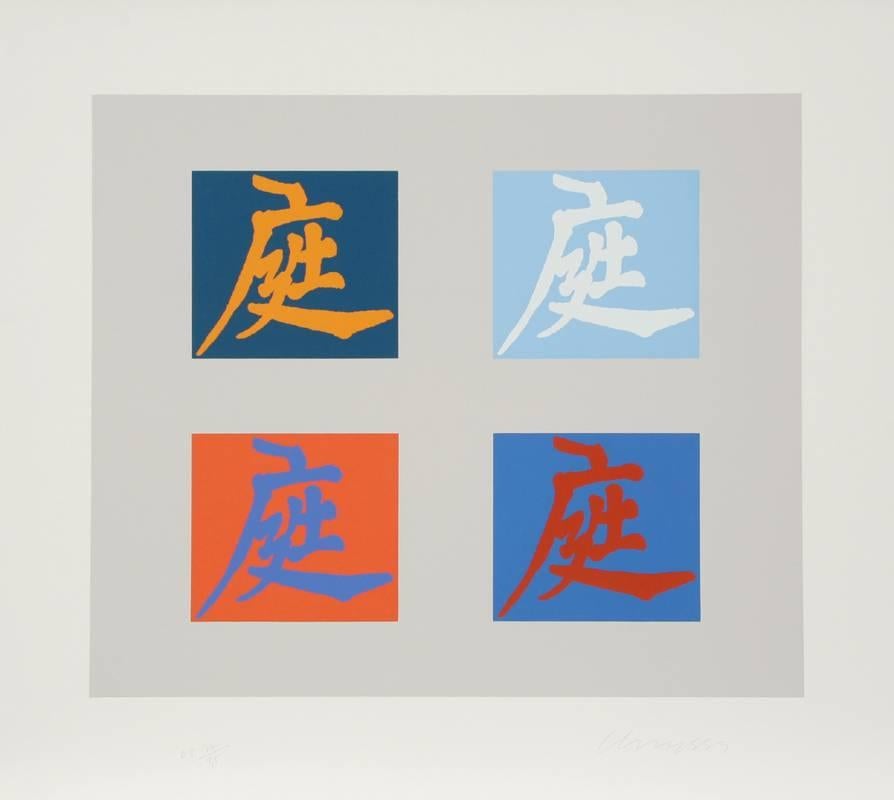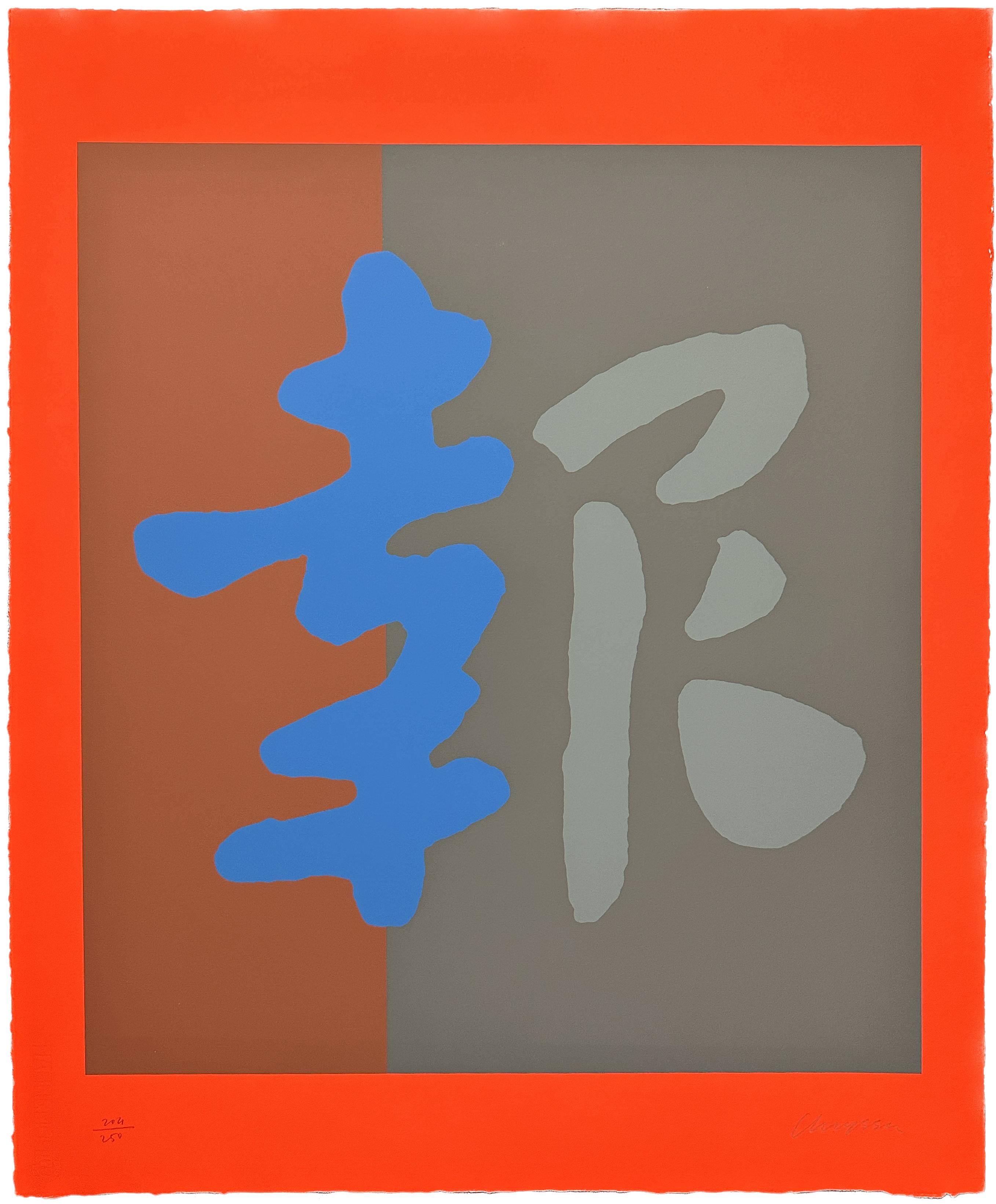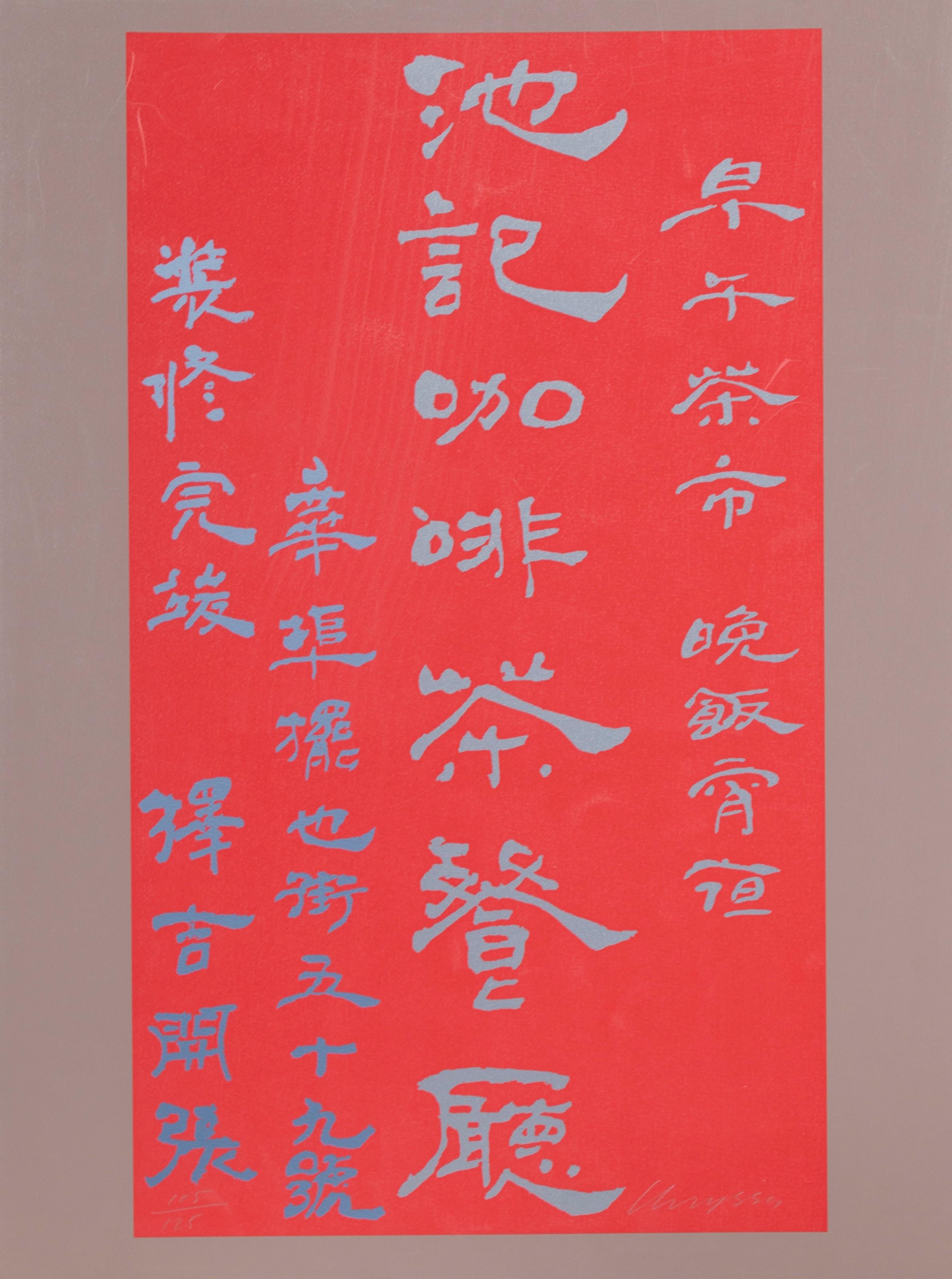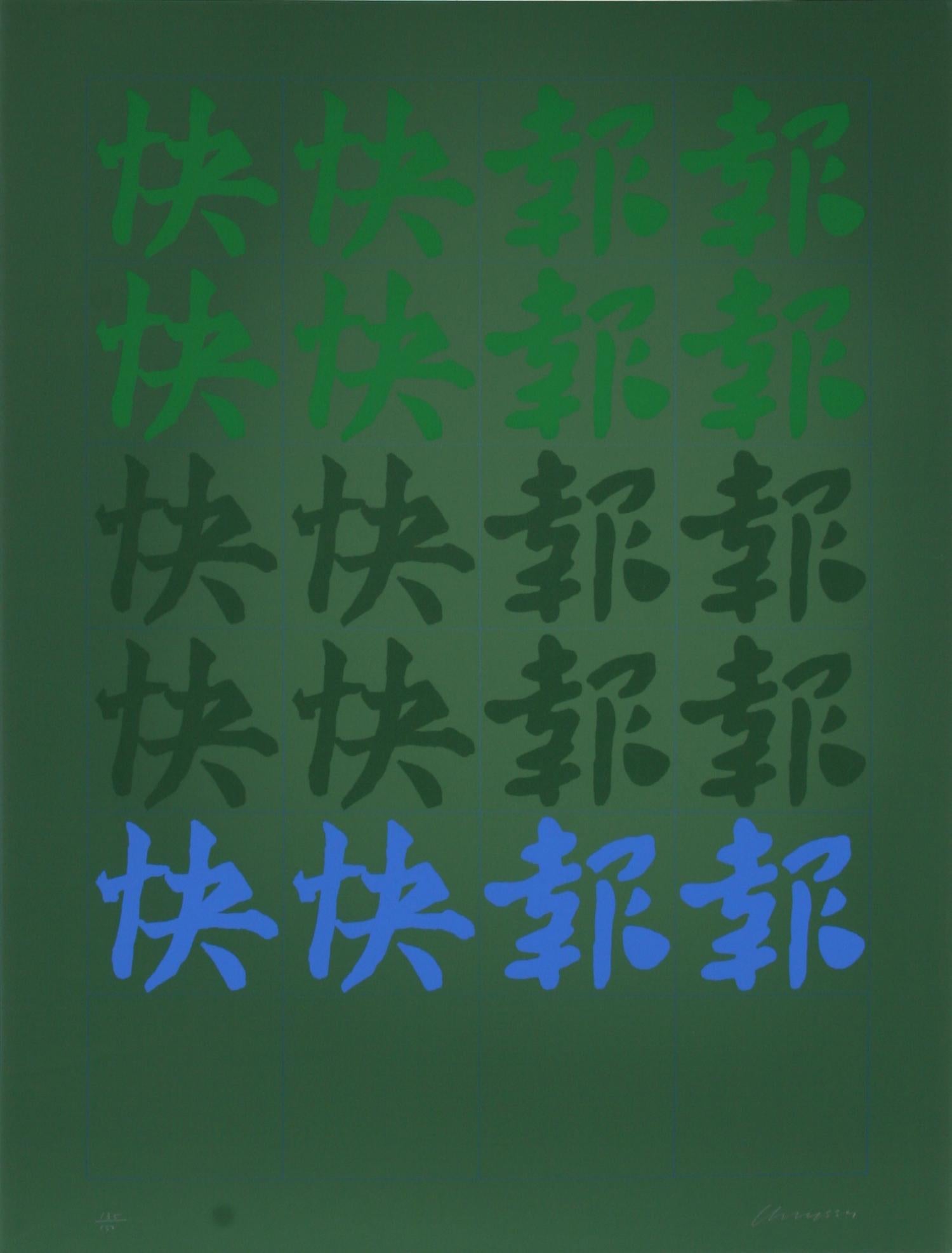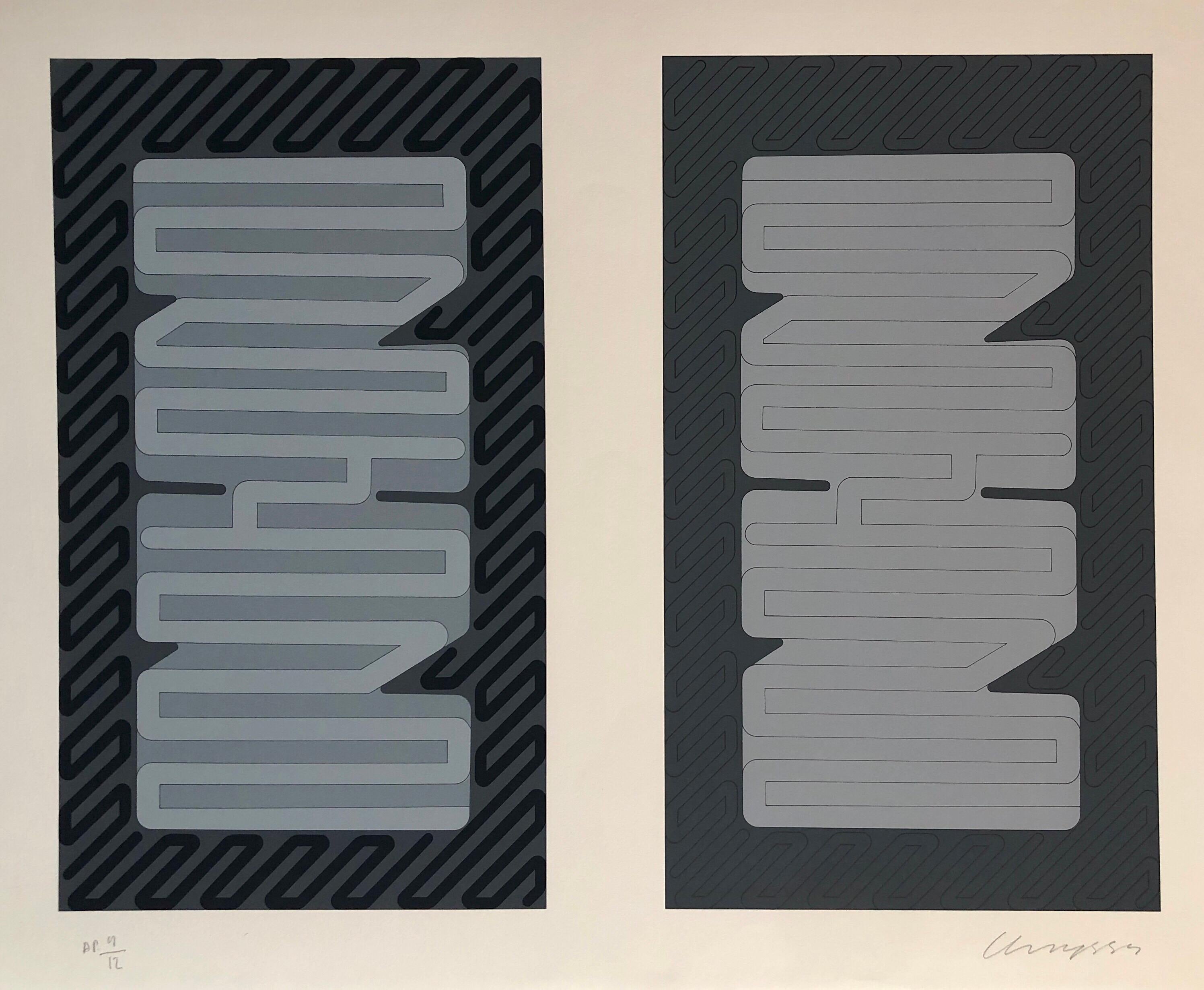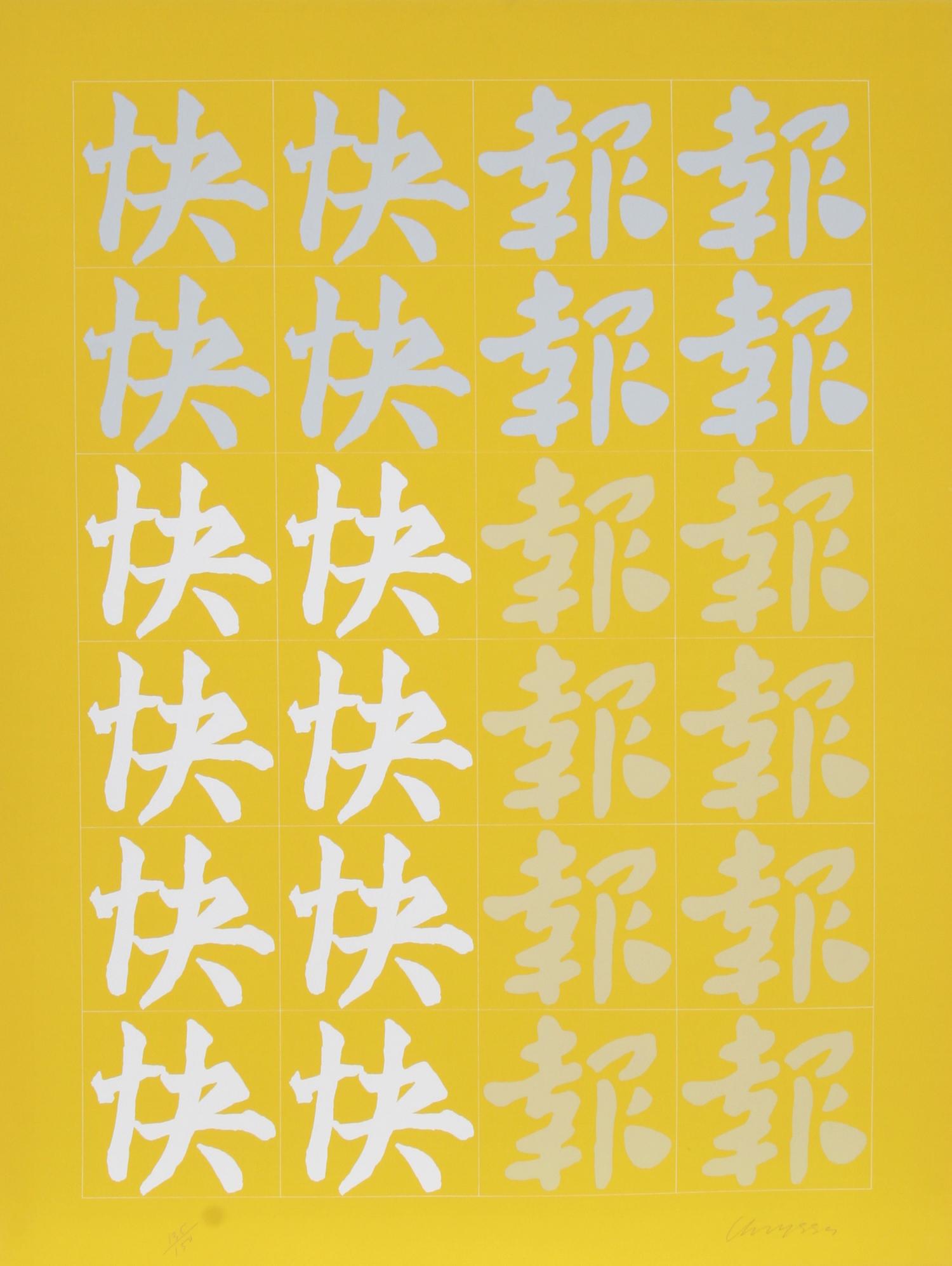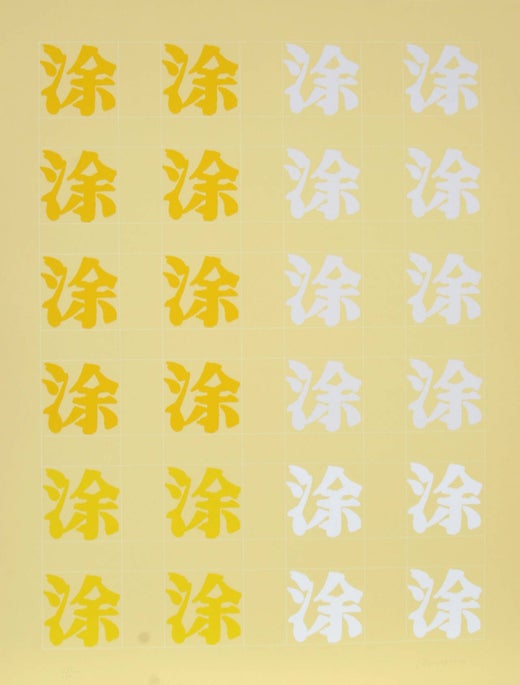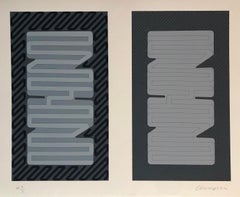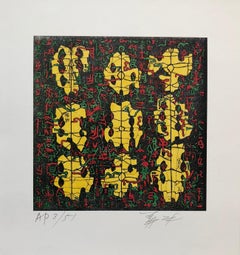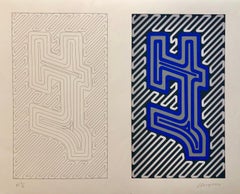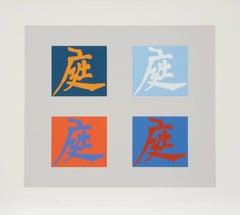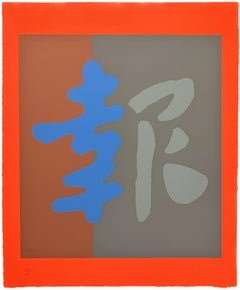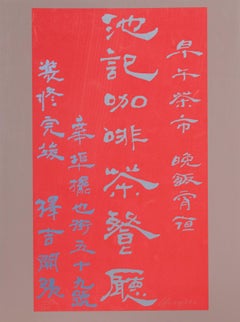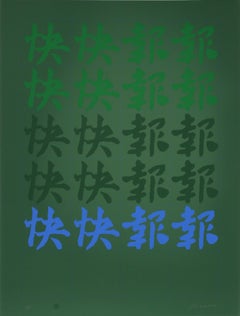Items Similar to 1980's Large Silkscreen Chinese Characters Serigraph Pop Art Print China
Want more images or videos?
Request additional images or videos from the seller
1 of 8
Chryssa Vardea-Mavromichali1980's Large Silkscreen Chinese Characters Serigraph Pop Art Print China1980
1980
$850
£647.84
€740.52
CA$1,195.90
A$1,310.07
CHF 689.57
MX$15,636
NOK 8,790.25
SEK 8,035.62
DKK 5,531.55
About the Item
Chryssa Vardea-Mavromichali (Greek: Χρύσα Βαρδέα-Μαυρομιχάλη; December 31, 1933 – December 23, 2013) was a Greek American artist who worked in a wide variety of media. An American art pioneer in light art and luminist sculpture widely known for her neon, steel, aluminum and acrylic glass installations, she has always used the mononym Chryssa professionally. She worked from the mid-1950s in New York City studios and worked since 1992 in the studio she established in Neos Kosmos, Athens, Greece.
Chryssa was born in Athens into the famous Mavromichalis family from the Mani Peninsula. one of her sisters, who studied medicine, was a friend of the poet and novelist Nikos Kazantzakis.
Chryssa began painting during her teenage years and also studied to be a social worker.In 1953, on the advice of a Greek art critic, her family sent her to Paris to study at the Académie de la Grande Chaumiere where Andre Breton, Edgard Varese, and Max Ernst were among her associates and Alberto Giacometti was a visiting professor.
In 1954, at age twenty-one, Chryssa sailed for the United States, arrived in New York and went to San Francisco, California to study at the California School of Fine Arts. Returning to New York in 1955, she became a United States citizen and established a studio in the city.
Chryssa's first major work was The Cycladic Books preceded American minimalism by seventeen years.
1961, Chryssa's first solo exhibition was mounted at The Guggenheim.
1963, Chryssa's work was shown at the Museum of Modern Art in curator Dorothy Canning Miller's Americans 1963 exhibition. The artists represented in the show also included Richard Anuszkiewicz, Lee Bontecou, Robert Indiana, Richard Lindner, Marisol, Claes Oldenburg, Ad Reinhardt, James Rosenquist and others.
1966, The Gates to Times Square, regarded as "one of the most important American sculptures of all time" and "a thrilling homage to the living American culture of advertising and mass communications." The work is a 10 ft cube installation of two huge letter 'A's through which visitors may walk into "a gleaming block of stainless steel and Plexiglas that seems to quiver in the play of pale blue neon light" which is controlled by programmed timers. First shown in Manhattan's Pace Gallery, it was given to the Albright-Knox Art Gallery in Buffalo, New York in 1972.
1972, The Whitney Museum of American Art mounted a solo exhibition of works by Chryssa.
That's All (early 1970s), the central panel of a triptych related to The Gates of Times Square, was acquired by the Museum of Modern Art between 1975 and 1979.
1973, Chryssa's solo exhibition at the Gallerie Denise René was reviewed for TIME magazine by art critic Robert Hughes before it went on to the Galleries Denise René in Düsseldorf and Paris.
Other works by Chryssa in composite honeycomb aluminum and neon in the 1980s and 1990s include Chinatown, Siren, Urban Traffic, and Flapping Birds.
Chryssa 60/90 retrospective exhibition in Athens in the Mihalarias Art Center. After her long absence from Greece, a major exhibition including large aluminum sculptures - cityscapes, "neon boxes" from the Gates to the Times Square, paintings, drawings etc. was held in Athens.
In 1992, after closing her SoHo studio, which art dealer Leo Castelli had described as "one of the loveliest in the world," Chryssa returned to Greece. She found a derelict cinema which had become a storeroom stacked with abandoned school desks and chairs, behind the old Fix Brewery near the city center in Neos Kosmos, Athens. Using the desks to construct enormous benches, she converted the space into a studio for working on designs and aluminum composite honeycomb sculptures. The Athens National Museum of Contemporary Art, which was founded in 2000 and owns Chryssa's Cycladic Books, is in the process of converting the Fix Brewery into its permanent premises.
Greek Exhibits, European Cultural Center of Delphi (Council of Europe). "Apollo's Heritage"(July 4, 2003 – July 30, 2003). Works by sixteen artists: Giorgio de Chirico, Salvador Dalí, Nikos Hadjikyriakos-Ghikas, Nikos Engonopoulos, Yannis Tsarouchis, Giorgos Sikeliotis, Takis, Arman, Fernando Botero, Chryssa, Dimitris Mytaras, Alekos Fassianos, Sarantis Karavouzis, Yiannis Psychopedis, Dimitris Sakellion, Georgios Xenos.
European Cultural Center of Delphi (Council of Europe). "Columns and Pillars" (July 1, 2005 – July 23, 2005). Works by Yannis Moralis, Costas Tsoclis, Alekos Fassianos, Sotiris Sorogas, Pavlos, Yiannis Psychopedis, Dimitris Mytaras, Opy Zouni, Novello Finotti, Stephan Antonakos, Chryssa, Günther Uecker, and others.
Solo exhibitions
1961: Solomon R. Guggenheim Museum
1965: Institute of Contemporary Art, Philadelphia
1968: Harvard University
1972: Whitney Museum of American Art
1979: Musée d'Art Moderne de la Ville de Paris
Group exhibitions
1961: Le Nouveau Réalisme à Paris et à New York, Galerie Rive Droite, Paris, June 1961
1963: Museum of Modern Art
1977: Documenta '77 in Kassel
1991: Princeton University Art Museum
1997: Leo Castelli Gallery
2000, 2003 & 2005: European Cultural Center of Delphi
2007: Hirshhorn Museum and Sculpture Garden
Collections
Albright-Knox Art Gallery
Boca Raton Museum of Art
Corcoran Gallery of Art
Empire State Plaza
Hirshhorn Museum and Sculpture Garden
Macedonian Museum of Contemporary Art in Thessaloniki
Museum of Modern Art
National Museum of Contemporary Art in Athens
Walker Art Center
Whitney Museum of American Art
- Creator:Chryssa Vardea-Mavromichali (1933 - 2013, Greek)
- Creation Year:1980
- Dimensions:Height: 25 in (63.5 cm)Width: 34 in (86.36 cm)
- Medium:
- Movement & Style:
- Period:
- Condition:minor wear.
- Gallery Location:Surfside, FL
- Reference Number:1stDibs: LU38213537702
Chryssa Vardea-Mavromichali
Chryssa, (born Chryssa Vardea Mavomichali) is best known for her "Luminist" sculpture in brilliantly colored neon tubing, was born in Greece and now ranks as one of the outstanding and innovative artists in America today. Chryssa has had individual and collective exhibition shows at the Museum of Modern Art, The Guggenheim, The Whitney -New York. Harvard University; Institute of Contemporary Art at the University of Pennsylvania; Carnegie Institute among many others.
About the Seller
4.9
Platinum Seller
Premium sellers with a 4.7+ rating and 24-hour response times
Established in 1995
1stDibs seller since 2014
1,846 sales on 1stDibs
Typical response time: 1 hour
- ShippingRetrieving quote...Shipping from: Surfside, FL
- Return Policy
More From This Seller
View All1970's Large Silkscreen Abstract Geometric Day Glo Serigraph Pop Art Print Neon
By Chryssa Vardea-Mavromichali
Located in Surfside, FL
Silkscreen on Arches paper, Hand signed and Numbered in Pencil. Serigraph in black, gray (silver).
Chryssa Vardea-Mavromichali (Greek: Χρύσα Βαρδέα-Μαυρομιχάλη; December 31, 1933 – December 23, 2013) was a Greek American artist who worked in a wide variety of media. An American art pioneer in light art and luminist sculpture widely known for her neon, steel, aluminum and acrylic glass installations, she has always used the mononym Chryssa professionally. She worked from the mid-1950s in New York City studios and worked since 1992 in the studio she established in Neos Kosmos, Athens, Greece.
Chryssa was born in Athens into the famous Mavromichalis family from the Mani Peninsula. one of her sisters, who studied medicine, was a friend of the poet and novelist Nikos Kazantzakis.
Chryssa began painting during her teenage years and also studied to be a social worker.In 1953, on the advice of a Greek art critic, her family sent her to Paris to study at the Académie de la Grande Chaumiere where Andre Breton, Edgard Varese, and Max Ernst were among her associates and Alberto Giacometti was a visiting professor.
In 1954, at age twenty-one, Chryssa sailed for the United States, arrived in New York and went to San Francisco, California to study at the California School of Fine Arts. Returning to New York in 1955, she became a United States citizen and established a studio in the city.
Chryssa's first major work was The Cycladic Books preceded American minimalism by seventeen years.
1961, Chryssa's first solo exhibition was mounted at The Guggenheim.
1963, Chryssa's work was shown at the Museum of Modern Art in curator Dorothy Canning Miller's Americans 1963 exhibition. The artists represented in the show also included Richard Anuszkiewicz, Lee Bontecou, Robert Indiana, Richard Lindner, Marisol, Claes Oldenburg, Ad Reinhardt, James Rosenquist and others.
1966, The Gates to Times Square, regarded as "one of the most important American sculptures of all time" and "a thrilling homage to the living American culture of advertising and mass communications." The work is a 10 ft cube installation of two huge letter 'A's through which visitors may walk into "a gleaming block of stainless steel and Plexiglas that seems to quiver in the play of pale blue neon light" which is controlled by programmed timers. First shown in Manhattan's Pace Gallery, it was given to the Albright-Knox Art Gallery in Buffalo, New York in 1972.
1972, The Whitney Museum of American Art mounted a solo exhibition of works by Chryssa.
That's All (early 1970s), the central panel of a triptych related to The Gates of Times Square, was acquired by the Museum of Modern Art between 1975 and 1979.
1973, Chryssa's solo exhibition at the Gallerie Denise René was reviewed for TIME magazine by art critic Robert Hughes before it went on to the Galleries Denise René in Düsseldorf and Paris.
Other works by Chryssa in composite honeycomb aluminum and neon in the 1980s and 1990s include Chinatown, Siren, Urban Traffic, and Flapping Birds.
Chryssa 60/90 retrospective exhibition in Athens in the Mihalarias Art Center. After her long absence from Greece, a major exhibition including large aluminum sculptures - cityscapes, "neon boxes" from the Gates to the Times Square, paintings, drawings etc. was held in Athens.
In 1992, after closing her SoHo studio, which art dealer Leo Castelli had described as "one of the loveliest in the world," Chryssa returned to Greece. She found a derelict cinema which had become a storeroom stacked with abandoned school desks and chairs, behind the old Fix Brewery near the city center in Neos Kosmos, Athens. Using the desks to construct enormous benches, she converted the space into a studio for working on designs and aluminum composite honeycomb sculptures...
Category
1980s Pop Art Abstract Prints
Materials
Screen
Chinese Abstract Modernist Signed Lithograph Hong Kong Modern Art
By Cheung Yee (Zhang Yi)
Located in Surfside, FL
Cheung Yee 張義 (b. 1936)
Born in Guangzhou, China, Cheung Yee graduated from the Fine Art Department of Taiwan Normal University in 1958, and five years later he formed the Circle Gr...
Category
20th Century Modern Abstract Prints
Materials
Lithograph
1970's Large Silkscreen Abstract Geometric Day Glo Serigraph Pop Art Print Neon
By Chryssa Vardea-Mavromichali
Located in Surfside, FL
Silkscreen on Arches paper, Hand signed and Numbered in Pencil. Serigraph in white, back, blue gray (silver).
Chryssa Vardea-Mavromichali (Greek: Χρύσα Βαρδέα-Μαυρομιχάλη; December 31, 1933 – December 23, 2013) was a Greek American artist who worked in a wide variety of media. An American art pioneer in light art and luminist sculpture widely known for her neon, steel, aluminum and acrylic glass installations, she has always used the mononym Chryssa professionally. She worked from the mid-1950s in New York City studios and worked since 1992 in the studio she established in Neos Kosmos, Athens, Greece.
Chryssa was born in Athens into the famous Mavromichalis family from the Mani Peninsula. one of her sisters, who studied medicine, was a friend of the poet and novelist Nikos Kazantzakis.
Chryssa began painting during her teenage years and also studied to be a social worker.In 1953, on the advice of a Greek art critic, her family sent her to Paris to study at the Académie de la Grande Chaumiere where Andre Breton, Edgard Varese, and Max Ernst were among her associates and Alberto Giacometti was a visiting professor.
In 1954, at age twenty-one, Chryssa sailed for the United States, arrived in New York and went to San Francisco, California to study at the California School of Fine Arts. Returning to New York in 1955, she became a United States citizen and established a studio in the city.
Chryssa's first major work was The Cycladic Books preceded American minimalism by seventeen years.
1961, Chryssa's first solo exhibition was mounted at The Guggenheim.
1963, Chryssa's work was shown at the Museum of Modern Art in curator Dorothy Canning Miller's Americans 1963 exhibition. The artists represented in the show also included Richard Anuszkiewicz, Lee Bontecou, Robert Indiana, Richard Lindner, Marisol, Claes Oldenburg, Ad Reinhardt, James Rosenquist and others.
1966, The Gates to Times Square, regarded as "one of the most important American sculptures of all time" and "a thrilling homage to the living American culture of advertising and mass communications." The work is a 10 ft cube installation of two huge letter 'A's through which visitors may walk into "a gleaming block of stainless steel and Plexiglas that seems to quiver in the play of pale blue neon light" which is controlled by programmed timers. First shown in Manhattan's Pace Gallery, it was given to the Albright-Knox Art Gallery in Buffalo, New York in 1972.
1972, The Whitney Museum of American Art mounted a solo exhibition of works by Chryssa.
That's All (early 1970s), the central panel of a triptych related to The Gates of Times Square, was acquired by the Museum of Modern Art between 1975 and 1979.
1973, Chryssa's solo exhibition at the Gallerie Denise René was reviewed for TIME magazine by art critic Robert Hughes before it went on to the Galleries Denise René in Düsseldorf and Paris.
Other works by Chryssa in composite honeycomb aluminum and neon in the 1980s and 1990s include Chinatown, Siren, Urban Traffic, and Flapping Birds.
Chryssa 60/90 retrospective exhibition in Athens in the Mihalarias Art Center. After her long absence from Greece, a major exhibition including large aluminum sculptures - cityscapes, "neon boxes" from the Gates to the Times Square, paintings, drawings etc. was held in Athens.
In 1992, after closing her SoHo studio, which art dealer Leo Castelli had described as "one of the loveliest in the world," Chryssa returned to Greece. She found a derelict cinema which had become a storeroom stacked with abandoned school desks and chairs, behind the old Fix Brewery near the city center in Neos Kosmos, Athens. Using the desks to construct enormous benches, she converted the space into a studio for working on designs and aluminum composite honeycomb sculptures...
Category
1980s Pop Art Abstract Prints
Materials
Screen
Abstract Expressionist Taiwanese Etching Chihung Yang Chinese Calligraphy Art
Located in Surfside, FL
S.O.C. #2
2014
Etching
76.5 x 91cm
Yang Chihung (Chinese: 楊識宏; pinyin: Yang Chihung; born 1947) Taiwanese-American artist.
Yang Chi-hung was born on 25 October 1947, in Chungli, Tai...
Category
2010s Abstract Expressionist Abstract Prints
Materials
Etching
Lyrical Abstract Expressionist Lithograph Cleve Gray Lithograph Silkscreen Print
By Cleve Gray
Located in Surfside, FL
Cleve Gray, American (1918-2004)
Composition, (1976)
serigraph or lithograph
Hand signed lower right, and editioned 9/50
Dimensions: 19.25 X 23.75 inches sheet.
unframed
Cleve Gray (1918 – 2004) was an American Abstract expressionist painter, who was also associated with Color Field painting and Lyrical Abstraction.
Gray was born Cleve Ginsberg, the family changed their name to Gray in 1936. Gray attended the Ethical Culture School in New York City (1924–1932). From the age of 11 until the age of 14 he had his first formal art training with Antonia Nell, who had been a student of George Bellows. From 15 to 18 he attended the Phillips Academy, in Andover, Massachusetts; where he studied painting with Bartlett Hayes and won the Samuel F. B. Morse Prize for most promising art student. In 1940 he graduated from Princeton University summa cum laude, with a degree in Art and Archeology. He was a member of Phi Beta Kappa. At Princeton he studied painting with James C. Davis and Far Eastern Art with George Rowley, under whose supervision he wrote his thesis on Yuan dynasty landscape painting. Best known for his calligraphic abstractions which melded elements of Abstract Expressionism, Color Field painting, and traditional Chinese scroll painting. After graduation in 1941 Gray moved to Tucson, Arizona. In Arizona he exhibited his modernist landscape paintings and still lifes at the Alfred Messer Studio Gallery in Tucson. In 1942 he returned to New York and joined the United States Army. During World War II, he served in the signal intelligence service in Britain, France and Germany, where he rose to the rank of sergeant. After the liberation of Paris he was the first American GI to greet Pablo Picasso and Gertrude Stein. He began informal art training with the French artists André Lhote and Jacques Villon, continuing his art studies in Paris after the war. Gray returned to the United States in 1946. In 1949 he moved to the house his parents had owned on a 94-acre property in Warren, Connecticut, and lived there for the rest of his life. In the 1960s he formed a close friendship with Barnett Newman. It was during this time that he experienced an artistic metamorphosis, dissolving his earlier cubist compositions in a sea of distilled color. This dramatic body of work marked the beginning of an artistic meditation that would last for over 40 years. The rigors of French modernism, the ethos of Abstract Expressionism and the meditative restraint of Chinese and Japanese scroll painting commingle with astounding affect. The atmospheric, subdued tones of his 1960s paintings gradually gave way to bright, monochromatic fields of color, hazily washed onto the canvas in stain like swathes. Much of his work from the last three decades of his career feature striking graphic brushwork that conjures the influence of Japanese and Chinese calligraphy. He married the noted author Francine du Plessix on April 23, 1957. They worked in separate studios in two outbuildings with a driveway in between. Gray was a veteran of scores of exhibitions throughout his career, as listed below, from the early days Tucson, through to postwar Paris and New York, and most recently in 2002 at the Berry-Hill Gallery in New York City. His paintings are held in the collections of numerous prominent museums and institutions. In 2009 the art critic Karen Wilkin curated a posthumous retrospective of his work at the Boca Raton Museum of Art, Florida, and other posthumous exhibitions have been held.
Museum collections
Addison Gallery of American Art, Phillips Academy, Andover, MA
Albright-Knox Art Gallery, Buffalo, New York
Boca Raton Museum of Art, Boca Raton, Florida
The Brooklyn Museum, New York City
Columbia University Art Gallery, New York City
Columbus Museum of Art, Ohio
The Corcoran Gallery of Art, Washington, D.C.
Grey Art Gallery and Study Center, New York University, New York City
Solomon R. Guggenheim Museum, New York City
Honolulu Museum of Art, Honolulu, Hawaii
The Jewish Museum, New York City
The Metropolitan Museum of Art, New York City
Museum of Art, Rhode Island School of Design, Providence
Museum of Fine Arts, Boston
Museum of Fine Arts, Houston
Museum of Modern Art, New York City
The Neuberger Museum, State University of New York at Purchase
New Britain Museum of American Art, Connecticut
The Newark Museum, New Jersey
Norton Gallery of Art, West Palm Beach, Florida
Oklahoma City Art Center, Oklahoma
The Phillips Collection, Washington, D.C.[14]
The Art Museum, Princeton University, New Jersey[6]
Rose Art Museum, Brandeis University, Waltham, Massachusetts
Sheldon Museum of Art, University of Nebraska, Lincoln
Smithsonian American Art Museum, Washington, D.C.
The Wadsworth Atheneum, Hartford, Connecticut
Whitney Museum of American Art, New York City
Yale University, New Haven, Connecticut
Williams College Museum of Art, Williamstown, Massachusetts
Yale University Art Gallery, New Haven, Connecticut
He was included in the show 1977, Group Exhibition, Betty Parsons Gallery. Mino Argento...
Category
1970s Abstract Expressionist Abstract Prints
Materials
Lithograph
Bright Vibrant Pop Art Silkscreen NYC Abstract Expressionist
By William Scharf
Located in Surfside, FL
Red Angel, intensely and seductively colored: swooning purples and reds, ecstatic lemon yellows, and black construction paper. Jostling shapes, geometric and biomorphic, lyrical and hard-edged, refuse to resolve neatly Assemblage, a bold strategy to keep viewers unsettled and curious, the reward for which are profuse and luscious details: varied incidents of refinement, suggestive signs, most in a private code, not merely ornamental but integral to the overall message.
William Scharf (born 1927, Media, PA) is an American artist from New York, he teaches at The Art Students League of New York. Painting with acrylics, he was a member of the New York School movement. Often categorized as a late generation Abstract Expressionist, Known for producing paintings with abstract compositions incorporating biomorphic and geometric forms in vivid colors, the artist was influenced by Surrealism, the Color Field painters, and symbolism.
He apprenticed with Mark Rothko and was influenced by his color field paintings. The surrealist painter Arshile Gorky and the Abstract expressionism style found in 1950s New York City also influenced Scharf. His exhibits include San Francisco Art Institute (1969), the Pepperdine University's Frederick R. Weisman Museum of Art (2001), and Richard York Gallery in New York City (2004).
In the heyday of Abstract Expressionism, being serious meant following the tenets of the New York School, which required abstract paintings to be spontaneous improvisations, the messier the better. At once hedonistic and disciplined, his brazen paintings are nothing if not promiscuous. The best ones mix the dynamism of gestural abstraction with sensual rhythms of decorative patterning, sometimes souping up the stew with cartoonish symbols and flourishes so ripe they belong in a dandy's fantasies. His exhibits include San Francisco Art Institute (1969), the Pepperdine University's Frederick R. Weisman Museum of Art (2001) and Richard York Gallery in New York City (2004).
Scharf's work has been exhibited in a number of galleries, including the Anita Shapolsky Gallery, Meredith Ward Fine Art, and Hollis Taggart Galleries in New York City.
Scharf has been an instructor of art at various institutions including The Art Students League, the San Francisco Art Institute, and the School of Visual Arts in New York. He is a member of the Society of Illustrators and the Artists Equity Association.
EDUCATION
1944-49 The Pennsylvania Academy of the Fine Arts — Philadelphia, PA (1948 Cresson Scholar)
1949 The University of Pennsylvania — Philadelphia, PA
1948 The Academie de la Grand Chaumiere — Paris, France
1947 The Barnes Foundation — Merion, PA
1939-41 Samuel Fleisher Memorial School— Philadelphia, PA (also known as Graphic Sketch Club)
TEACHING HISTORY
Instructor: Painting & Drawing
1987-Present Art Students League, New York, NY
1989, 74, 69, 66, 63 San Francisco Institute of Fine Arts, San Francisco, CA
1965-69 he School of Visual Arts, New York, NY
1964 Art Center of the Museum of Modern Art, New York, NY
Guest Lecturer
1979 Pratt Institute, New York, NY
1974 Stanford University, Palo Alto, CA
1974 California College of Arts and Crafts, San Francisco, CA
Recent Solo Exhibitions:
2005 Meredith Ward Fine Art, New York, NY
2004 Richard York Gallery, New York, NY
2002 P.S.1/MOMA, Queens, NY
2001 The Frederick R. Weisman Museum of Art, Malibu, CA
2000-2001 The Phillips Collection, Washington, DC
Selected Group Exhibitions:
2005 National Academy of Design, New York, NY
2005 Peter McPhee Fine Arts, Stone Harbor...
Category
1970s Abstract Expressionist Abstract Prints
Materials
Lithograph, Screen
You May Also Like
"Tranquility #5, " Serigraph, 1979, Pop Art Screenprint by Chryssa
By Chryssa Vardea-Mavromichali
Located in Long Island City, NY
This serigraph was created by Greek artist Chryssa. An American art pioneer in light art and luminist sculpture widely known for her neon, steel, and acrylic glass installations, Chr...
Category
1970s Abstract Geometric Abstract Prints
Materials
Screen
Chryssa 1979 Signed Limited Edition Screen Print Chinatown Series Red
By Chryssa Vardea-Mavromichali
Located in Rochester Hills, MI
Chryssa
Chinatown - 1979
Print - Serigraph 38.5'' x 31'' inches
Edition: Signed in pencil and marked 204/250
Chryssa, (born Chryssa Vardea Mavomichal...
Category
1970s Abstract Abstract Prints
Materials
Screen
Untitled - Chinese Characters - Conceptual Art Screenprint by Chryssa
By Chryssa Vardea-Mavromichali
Located in Long Island City, NY
Untitled - Chinese Characters (Red on Mauve)
Chryssa, Greek (1933–2013)
Date: circa 1979
Screenprint, signed and numbered in pencil
Edition of 125
Size: 30 x 22 in. (76.2 x 55.88 cm)
Category
1970s Abstract Geometric Abstract Prints
Materials
Screen
Chinatown Portfolio II, Image 8 - Conceptual Screenprint by Chryssa
By Chryssa Vardea-Mavromichali
Located in Long Island City, NY
Artist: Chryssa, Greek (1933 - 2013)
Title: Chinatown Portfolio II, Image 8
Year: circa 1978
Medium: Screenprint, signed and numbered in pencil
Edition: 150
Size: 40 in. x 30.5 in....
Category
1970s Conceptual Abstract Prints
Materials
Screen
Chinatown Portfolio II, Image 1, Conceptual Screenprint by Chryssa
By Chryssa Vardea-Mavromichali
Located in Long Island City, NY
Artist: Chryssa, Greek (1933 - 2013)
Title: Chinatown Portfolio II, Image 1
Year: circa 1978
Medium: Screenprint, signed and numbered in pencil
Edition: 150
Size: 40 in. x 30.5 in....
Category
1970s Conceptual Abstract Prints
Materials
Screen
Chryssa 1979 Signed Limited Edition Screen Print Chinatown Series Tan
By Chryssa Vardea-Mavromichali
Located in Rochester Hills, MI
Chryssa
Chinatown - 1979
Print - Serigraph 38.5'' x 31'' inches
Edition: Signed in pencil and marked 207/250
The bright lights and signage of Manhattan became an important source of inspiration for the Greek-born artist Chryssa Vardea...
Category
1970s Abstract Abstract Prints
Materials
Screen
More Ways To Browse
Chinese Character
Siren Vintage
Vintage Neon Light
Pillars And Columns
Timer Vintage
Vintage Neon Sculpture
Large Chinese Screens
Serigraph 1980s
Neon 1980s
Used School Desks And Chairs
Niko Ghika
Yannis Moralis
Yannis Tsarouchis
Nazi Uniform
Paul Collomb
Richard Reed
Robert Motherwell Elegy
Robert Natkin Lithograph
